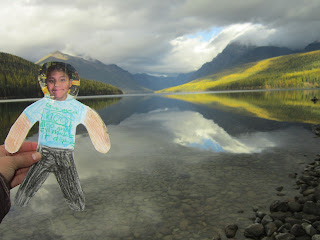On October 19, 2012 our class headed to Ovando, MT to learn
about cooperative conservation from the Blackfoot Challenge. After a few unfortunate events, locking the
car with the keys inside and one group having to stop and get gas, we all
finally made it. At Ovando we met up with Jim Stone, chair of the Blackfoot
Challenge and owner of Rolling Stone Ranch. He was kind enough to spend the day
with us, and we all went into a building to get out of the rain. Jim started by
telling us a little about his family (like his Great-Great Grandfather starting
Journalism at UM!) and that his family has always been in the ranching
business. Even though Jim graduated from MSU, we were still very interested in
what he could tell us about the Blackfoot Challenge.
 The Challenge consists of a twenty member board and they
meet once a month. Jim emphasized the fact that they try to bring everyone to
the table, and not leave out the people they know will disagree. He said the
Challenge is more about bringing people together, and it is more knowledge and
understanding based than decision based. They don’t like to make decisions
because they want trust from their neighbors and don’t want to be seen as a
“green group” or a bunch of hicks either. Along with the board they have
committees, for things like timber, water, education, strategies, weeds, etc. They
involve partners, work groups, and over 500 landowners. Jim said the biggest
thing about the Challenge is to involve everyone and maintain open
communication. They exercise the 80/20 rule-when you come to a meeting you take
off your rancher or miner hat, and talk about the 80% of things you can agree
on. Jim says his biggest benefit from being involved is the knowledge he gains
from the people he meets, gaining contacts, and networking.
The Challenge consists of a twenty member board and they
meet once a month. Jim emphasized the fact that they try to bring everyone to
the table, and not leave out the people they know will disagree. He said the
Challenge is more about bringing people together, and it is more knowledge and
understanding based than decision based. They don’t like to make decisions
because they want trust from their neighbors and don’t want to be seen as a
“green group” or a bunch of hicks either. Along with the board they have
committees, for things like timber, water, education, strategies, weeds, etc. They
involve partners, work groups, and over 500 landowners. Jim said the biggest
thing about the Challenge is to involve everyone and maintain open
communication. They exercise the 80/20 rule-when you come to a meeting you take
off your rancher or miner hat, and talk about the 80% of things you can agree
on. Jim says his biggest benefit from being involved is the knowledge he gains
from the people he meets, gaining contacts, and networking.
After this talk, we headed over to land that used to be
owned by Plum Creek Timber Company. When Plum Creek owned it, the land was open
to recreation and other uses. Residents wanted to maintain this public access
when the land went up for sale. The Nature Conservancy of Montana contributed
to this project by buying 14,000 acres, and total purchased land for the
project was nearly 70,000 acres. This is a great example of the Challenge’s
dedication to the goal of protecting the rural character of the valley, through
cooperative conservation.








